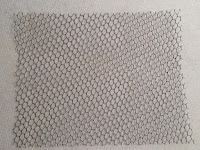Using transparent fabric
There are various types of transparent fabric that can provide may options for use as overlays. Here are such a sampling as presented by Lorraine at our last meeting.NETTING - a fabric that is knotted to form a mesh (not woven or knitted)
TULLE (Veiling) - hexagonal net (knotted) mesh. This is a smaller mesh than netting. It may melt with ironing and can be caught and torn.
ORGANZA - fine, stiff, wiry, woven fabric. This is typically silk, viscose (rayon) or polyester. Similar to organza is organdy. Organdy is made of cotton and used for interfacings.
CHIFFON is a plain weave, soft filmy fabric and may be made from silk, nylon, viscose, cotton or polyester. Because it frays easily, it is best to sew on first and then cut close to the stitches, or lay it down using Mistyfuse. It's also used for embellishing.

These transparent fabrics can be used as overlays to produce shading, holding fabric confetti or other items in place, mute the colour or properties of the colour underneath, or add texture.
Using Yarn / Thread
YARN - spun fibres used for knitting, weaving or sewing. Some samples of yarn are:
Boucle - loops of fibres spun into a core of yarn
Eyelash yarn - tuffed materials attached to a solid core of yarn


Chenille (French for caterpillar) is a yarn with a protruding pile around a core

THREAD - twisted filaments, fibres or fibrous material spun into a length, usually composed of two or more lengths twisted together.
Embroidery Thread - 2-6 ply, cotton, rayon, silk
Yarn or thread can be attached to your quilt by some of the following methods:
Couching - by machine or hand
Felting - needle or embellishing machine
Yarn piping - fold fabric in half, zigzag along the folded edge (this edge is your piping)
Secured under transparent overlay
- lay down Misty Fuse on base (fabric or batting)
- lay down yarn(s) in desired pattern
- place tulle on top
- stitch
Tips and Tricks Learned Today
Try sewing cording or yarn under the fabric.Battlizer - batting and stabilizer combined in one product - can get it locally at Pleasant Valley Quilting.
To get the pieces squared for our project Cathy cuts out a piece of cardboard to the correct size. Once she has sewn the 'pillowcase' she turns the project right side out, slips the cardboard inside and then irons it.































